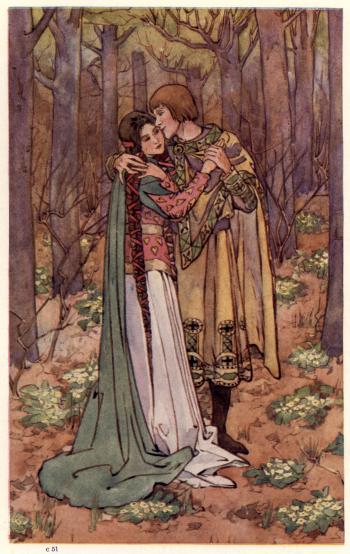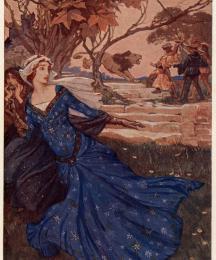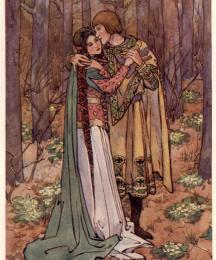The "Fair Unknown" is a universally popular folk motif with strong Arthurian connections in which a young man of questionable lineage becomes an integral part of society. Initially appearing in court without an established identity, the Fair Unknown nevertheless boldly demands to be knighted. He tends to be markedly — albeit amusingly — uninhibited because of his isolated upbringing, and frequently knows little of his own paternity. Although he is quickly knighted, the Fair Unknown must prove his worth through an extended series of adventures before finally cementing his position within society through continued proof of his prowess and, ultimately, through marriage and the acquisition of property. Within the Arthurian tradition specifically, the Fair Unknown is usually discovered to be a relative of Gawain and, thus, related to Arthur himself. He must, therefore, prove himself worthy of being not only an Arthurian knight, but also Gawain and Arthur's kinsman.
Common themes/motifs within "Fair Unknown" romances: concealed identities, nicknames,
Fier Baiser or "daring kiss" through which the hero transforms an enchanted heroine from a serpent back into a maiden, emphases on individual acts over established reputations, and tensions between those who act to uphold ideals versus those who simply talk about them.
Popular romance themes/motifs frequently employed by "Fair Unknown" romances: sparrowhawk contests, seduction by a fairy, prevention of rape, battles at bridges or fords, fighting with giants, demanding boons (including knighthood), youth and beauty of heroes, loathly ladies, fighting brothers, messenger maidens and accompanying dwarfs, total victory over opponents, tournaments to re-instate heroes in Arthurian...
Read More
Read Less
The "Fair Unknown" is a universally popular folk motif with strong Arthurian connections in which a young man of questionable lineage becomes an integral part of society. Initially appearing in court without an established identity, the Fair Unknown nevertheless boldly demands to be knighted. He tends to be markedly — albeit amusingly — uninhibited because of his isolated upbringing, and frequently knows little of his own paternity. Although he is quickly knighted, the Fair Unknown must prove his worth through an extended series of adventures before finally cementing his position within society through continued proof of his prowess and, ultimately, through marriage and the acquisition of property. Within the Arthurian tradition specifically, the Fair Unknown is usually discovered to be a relative of Gawain and, thus, related to Arthur himself. He must, therefore, prove himself worthy of being not only an Arthurian knight, but also Gawain and Arthur's kinsman.
Common themes/motifs within "Fair Unknown" romances: concealed identities, nicknames,
Fier Baiser or "daring kiss" through which the hero transforms an enchanted heroine from a serpent back into a maiden, emphases on individual acts over established reputations, and tensions between those who act to uphold ideals versus those who simply talk about them.
Popular romance themes/motifs frequently employed by "Fair Unknown" romances: sparrowhawk contests, seduction by a fairy, prevention of rape, battles at bridges or fords, fighting with giants, demanding boons (including knighthood), youth and beauty of heroes, loathly ladies, fighting brothers, messenger maidens and accompanying dwarfs, total victory over opponents, tournaments to re-instate heroes in Arthurian society, and "happy" endings in marriage.
See motifs D735, H151.10, H151.11, H480ff, H921, H1216, H1382, N682, and R222 in Aarne and Thompson, Motif-Index of Folk-Literature, 6 vols, rev. edition (Bloomington: Indiana University Press, 1955-57).
TEXTS
The four romances generally referred to as the "Fair Unknown" group are:
-
Le Bel Inconnu. A 6, 266 line French verse romance attributed to Renaut de Beaujeu or Renaud de Bâgé and dated between 1185 and 1190 that relates the story of Gawain's son, Guinglain, and the many adventures associated with his liberating the daughter of the King of Wales, Esmeree, from an enchantment that transformed her into a serpent. Although young and inexperienced, Guinglain conquers a bridge keeper and his avenging family, two giants, a hunter, a sorceress, and two enchanters in his efforts to free Esmeree, whom he ultimately marries.
See Le Bel Inconnu. Ed. Karen Fresco. Trans. Colleen Donagher. New York: Garland, 1992.
--- Le Bel Inconnu. Ed. Michèle Perret and Isabelle Weil. Paris: Champion, 2003.
-
Wigalois. An 11,700 line German verse romance by Wirnt von Grafenberg dated between 1200 and 1215 that is very similar to Le Bel Inconnu, especially towards its beginning, but which goes into much more detail about the history of its hero's conception. Wigalois goes in search of his father, Gawain, when he is twenty. While at court he encounters many of the traditional "Fair Unknown" adventures, but Wigalois' story is continuously framed by stories of his father. The relationship between the two is not only acknowledged, but also celebrated. It is, therefore, the affirmation of this relationship and not the impetus to prove knightly prowess that is the motivating force behind this narrative.
See Wigalois: Der Ritter mit dem Rade. Ed. J. M. N. Kapteyn. Bonn: F. Klopp, 1926.
--- Wigalois: The Knight of Fortune's Wheel. Trans. J. W. Thomas. Lincoln: University of Nebraska Press, 1977.
-
Lybeaus Desconus. A considerably shorter English verse romance of approximately 1200 lines commonly attributed to Thomas Chestre and dated to the mid or late fourteenth century that reads like an abridged version of Le Bel Inconnu. Many of the episodes in Lybeaus appear to be taken directly from Le Bel, although the order in which they are presented varies between the two texts. In Lybeaus, it is the narrator who announces that the hero, Gyngalyn, is Gawain's son--Gyngalyn himself does not know this. He is brought up by his mother and named Lybeaus Desconus ("Fair Unknown") by Arthur when he appears at court seeking knighthood and adventure. Initially scorned, he goes on to prove his chivalric competence and social worth through a variety of prowess-testing adventures.
See Lybeaus Desconus. Ed. M. Mills. EETS o.s. 261. London: Oxford University Press, 1969.
-
Carduino. A one hundred and seven stanza Italian verse romance generally attributed to Antonio Pucci and dated to the 1370s that is divided into two cantari, the first relating Carduino's childhood of ignorance in a forest, and the second recounting his adventures in an Enchanted City. The first cantare is reminiscent of Chrétien's Perceval. Carduino's father--Arthur's favorite knight--is murdered and his widow flees with their young child to the woods where she raises him without any knowledge of knights or knighthood. However, when Carduino is twelve he sees knights and becomes determined to serve them. At Arthur's court, his ignorance offends everyone until a damsel and a dwarf arrive and ask for a champion. The second cantare is more like a story about Gawain's kinsmen. Carduino has many adventures, culminating in his marriage to the lady Beatrice after freeing her from an enchantment that had turned her into a serpent.
See I cantari di Carduino giuntovi quello di Tristano e Lancielotto quando combattettero al petrone di Merlino. Ed. Pio Rajna. In Poemetti Cavallereschi. Bologna: Gaetano Romagnoli, 1873. Pp. 1-44.
Other "Fair Unknown" Texts:
-
Ulrich von Zatzikhoven's Lanzelet (c. 1194) exhibits a strong emphasis on the secret of its hero's birth. The loathly lady and Fier Baiser motifs are also present.
See Lanzelet. Ed. René Pérennec. Grenoble: ELLUG, 2004.
--- Lanzelet. Trans. Thomas Kerth. New York: Columbia University Press, 2005.
-
Chrétien de Troyes' Le Conte du Graal ("The Story of the Grail," c. 1180-91) and its subsequent continuations, two of which contain accounts of the begetting of the Fair Unknown. Chrétien's narrative employs many motifs traditionally associated with "Fair Unknown" romances including the hero's secluded upbringing, unknown lineage, brash behavior, and his demand to be knighted. In the First Continuation (Anonymous, c. 1200), Gawain's son is the product of his liaison with a maiden in a tent that angers her family. As a five-year-old, the child is sent by his mother to interrupt a fight between his father and his uncle, Bran, which he ultimately accomplishes by trying to catch the fighting men's swords. The boy is later abducted and instructed to challenge all who try to cross a specific ford. He unknowingly fights his father here, until Gawain inquires after his name and surrenders upon learning that the young knight is his son. After revealing his own identity, Gawain brings the boy back to Arthur's court with him. In the Second Continuation (Anonymous, also c. 1200), Perceval encounters the Fair Unknown and they joust. When the boy discovers Perceval's identity he surrenders and identifies himself as Gawain's son. He later reveals his identity directly to Gawain, explaining that it was Arthur himself who named him the Fair Unknown. In Studies in Libeaus Desconus (1895), William Schofield argues that Perceval is in fact the original identity of and source for the Fair Unknown heroes.
See Le Roman de Perceval: ou, Le Conte du Graal. Ed. William Roach. 2nd ed. Paris: Librairie Minard, 1959.
--- Perceval (Le Conte du Graal). Trans. Keith Busby. London: Grant & Cutler, 1993.
-
La Cotte Mal Taillee ("The Badly Tailored Coat," an episode from the Prose Tristan, Anonymous and c. 1235) is believed by many scholars to be a direct source for Malory. La Cotte, also known as Brunor, conceals his noble birth and begins his career as a humble knight. He is mocked by Kay and given his somewhat insulting nickname. He undertakes an adventure on behalf of a maiden and much to her dismay, but ends up marrying her after he is suspected of being of noble blood because of his courteous behavior.
See Roman de Tristan en prose. 9 vols. Geneva: Droz, 1987-1997.
--- Roman de Tristan en prose. Trans. Renée L. Curtis. Oxford: Oxford University Press, 1994.
-
Peredur (c. 1200), the Welsh equivalent of Le Conte du Graal, shares many similarities with Chrétien's unfinished tale, including a variety of Fair Unknown motifs and themes.
See Historia Peredur vab Evrawg. Ed. Glenys Witchard Goetinck. Cardiff: Gwasg Prifysgol Cymru, 1976.
--- The Mabinogion. Trans. Gwyn Jones and Thomas Jones. London: J. M. Dent, 1949, repr., 2004. Pp. 152-88.
-
Gogulor (Anonymous, c. 13th cent.), a 136 line verse fragment of a Fair Unknown romance, describes a battle between its hero and a giant and a marriage to an unwilling young maiden. The name Gogulor also appears in Gerbert's Continuation of Le Conte du Graal (c. 1230).
See Charles H. Livingston, ed. "Fragment d'un roman de chevalerie," Romania, 66 (1940-41), 85-93.
-
Beaudous (Robert de Blois, second half of 13th cent.), a verse romance by a man better known for explicitly didactic works, follows the traditional pattern of the Fair Unknown narrative with its unidentified hero winning renown through a series of adventures that culminate in marriage and the inheritance of a kingdom.
See Beaudos. Sämmtliche Werke, vol. 1. 1889; repr, 3 vols. in 1, Geneva: Slatkin Reprints, 1978.
-
Laoidh an Amadain Mhoir ("The Lay of the Great Fool," Anonymous and undated), a Gaelic ballad found in both Scotland and Ireland, it does not specifically mention Arthur or Gawain but does have as its hero a fool who embodies many of the Fair Unknown motifs.
See Popular Tales of the West Highlands. Ed. and trans. John Francis Campbell. Vol. 3. Paisely, 1892; repr., Wildwood Press, 1983.
-
Other English Romances with thematic similarities: Sir Perceval of Galles, Sir Degaré, Ipomadon and Book I of Edmund Spenser's Faerie Queene. Larry Benson actually suggests that some version of Ipomadon is the source of Malory's original contribution to the Fair Unknown genre.
See The Faerie Queene. Ed. Thomas P. Roche Jr. New York: Penguin Books, 1978. Pp. 39-202.
--- Ipomadon. Ed. Rhiannon Purdie. Oxford: Oxford University Press, 2001.
--- The Middle English Breton Lays. Ed. Anne Laskaya and Eve Salisbury. Kalamazoo, MI: Medieval Institute Publications, 1995. Pp. 89-144. [Sir Degaré.]
--- Sir Perceval of Galles and Ywain and Gawain. Ed. Mary Flowers Braswell. Kalamazoo, MI: Medieval Institute Publications, 1995. Pp. 1-76.
The Fair Unknown and Malory
Malory's Tale of Sir Gareth (1460-62?) bears a strong resemblance to the Fair Unknown romances. Gareth--a young, handsome, and large man--arrives at court during a feast and asks a boon, which ultimately enables him to claim a lady's adventure. He conceals information about his identity and is given an insulting nickname by Kay. Gawain is one of two knights to stand up for Gareth before the appearance of a distressed lady initiates Gareth's prowess-proving adventures. Gareth asks to be made a knight but the lady still disapproves of her champion and frequently tells him so. She leaves Arthur's court and Gareth hurries to catch her after being armed by his dwarf. In spite of the lady's continual scorn, Gareth defeats many opponents and sends them to Arthur before ultimately rescuing and winning his lady, Lyones. Malory's tale, however, postpones the "happy" ending much longer than most Fair Unknown narratives. Lyones refuses to let Gareth enter her castle after he defeats her foe who, it is worth noting, is not an enchanter or an enchantment. Even after the would-be lovers are united, a series of bed tests continue to delay the expected resolution. Thus, Malory seems to be conflating a variety of sources, complicating already existing narrative models to suggest that there is more to Gareth's story than simply proving his prowess. He not only develops into a strong knight, but also grows to embody idealized values such as courteousness in words and deeds, respect for the prowess of others, and reverence for marriage--the widespread lack of which ultimately contributes to the downfall of Arthurian society.
The Tale of Sir Gareth is not, however, Malory's only significant use of Fair Unknown motifs. Malory writes his own version of the Tristan story of Brunor--La Cote Mal Taile--in which Brewnor, like Gareth, conceals his parentage at the beginning of his career as a knight. He too is mocked by Kay and undertakes an adventure to aid a lady against her maiden's wishes until his nobility begins to be suspected. Not surprisingly, he is also eventually successful in his quest, although he does need Lancelot's assistance to become so on two separate occasions.
See Works. Ed. Eugène Vinaver. 2nd ed. Oxford: Oxford University Press, 1971.
BibliographyBenson, Larry D. Malory's Morte Darthur. Cambridge, MA: Harvard University Press, 1976. Pp. 92-108.
Honemann, Volker. "The Wigalois Narratives." In The Arthur of the Germans: The Arthurian Legend in Medieval German and Dutch Literature. Ed. W. H. Jackson and S. A. Ranawake. Cardiff: University of Wales, 2000. Pp. 142-54.
Lupack, Alan. The Oxford Guide to Arthurian Literature and Legend. Oxford: Oxford University Press, 2005. Pp. 317-20 and 443-44.
McHugh, Sheila Joyce. "The 'Lay of the Big Fool': Its Irish and Arthurian Sources." Modern Philology 42.4 (1945), 197-211.
Sanders, Arnold. "Sir Gareth and the 'Unfair Unknown': Malory's Use of the Gawain Romances." Arthuriana 16.1 (Spring 2006), 34-46.
Schofield, William H. Studies in Libeaus Desconus. Harvard Studies and Notes in Philology and Literature 4 (1985).
Thomas, Neil. "The Sources of Wigamur and the German Reception of the Fair Unknown Tradition." Reading Medieval Studies 19 (1993), 97-111.
Walters, Lori. "'A Love That Knows No Falsehood': Moral Instruction and Narrative Closure in the Bel Inconnu and Beaudous." South Atlantic Review 58.2 (1993), 21-39.
Wilson, Robert H. "The 'Fair Unknown' in Malory." PMLA 58:1 (March 1943), 1-21.
Read Less








